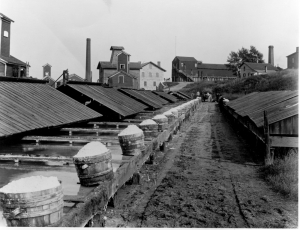Local History
In addition to the online historic photo collection, Liverpool Legends videos and walking tours of Liverpool's past available from the library, there are several nearby museums that highlight local history.
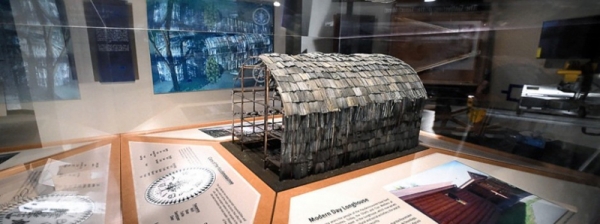 The Skä•noñh – Great Law of Peace Center is a Haudenosaunee (Iroquois) Heritage Center focused on telling the story of the native peoples of central New York. The history is told through the lens of the Onondaga Nation and covers topics such as Creation, European Contact, The Great Law of Peace, and more. The Onondagas, or People of the Hills, are the keepers of the Central Fire and are the spiritual and political center of the Haudenosaune. The facility is operated by the Onondaga Historical Association.
The Skä•noñh – Great Law of Peace Center is a Haudenosaunee (Iroquois) Heritage Center focused on telling the story of the native peoples of central New York. The history is told through the lens of the Onondaga Nation and covers topics such as Creation, European Contact, The Great Law of Peace, and more. The Onondagas, or People of the Hills, are the keepers of the Central Fire and are the spiritual and political center of the Haudenosaune. The facility is operated by the Onondaga Historical Association.
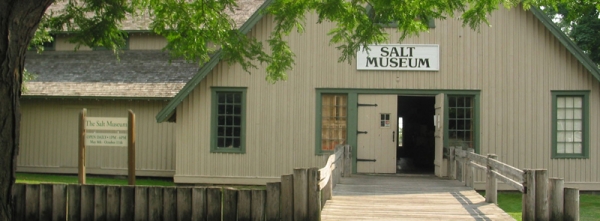 The Salt Museum, located on the shore of Onondaga Lake, is full of dynamic exhibits and artifacts. Constructed from timbers taken from actual salt warehouses, it provides an old time rustic experience during your visit. Open in the summer.
The Salt Museum, located on the shore of Onondaga Lake, is full of dynamic exhibits and artifacts. Constructed from timbers taken from actual salt warehouses, it provides an old time rustic experience during your visit. Open in the summer.
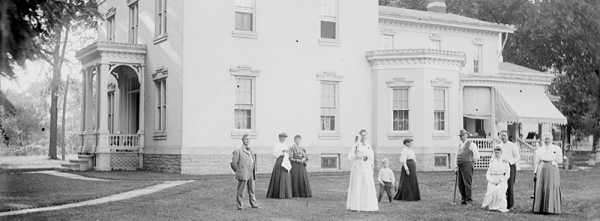 Liverpool Village Museum at the Gleason Mansion offers exhibits and resources for people interested in Liverpool history; the historian also presents programs of historical interest. The Willow Museum, open in the summer, celebrates Liverpool's willow basket weaving industry.The 1857 Gleason Mansion is listed on the State and National Registers of Historic Places.
Liverpool Village Museum at the Gleason Mansion offers exhibits and resources for people interested in Liverpool history; the historian also presents programs of historical interest. The Willow Museum, open in the summer, celebrates Liverpool's willow basket weaving industry.The 1857 Gleason Mansion is listed on the State and National Registers of Historic Places.
Below is a brief timeline of the area from 1500 to today.
Around 1500, in the forest surrounding shining Lake Gannentaha (now called Onondaga Lake), a council fire was lit. As it burned, representatives of five Indian nations assembled to hear the words of Hiawatha: “Be a united people and you will conquer your enemies." Thus was formed the Iroquois Confederacy, on the rise of ground near what was to become Liverpool.
Here is a brief timeline of European contact in the area:
- 1615 - Samuel de Champlain - traveled with the Huron. Some say he was here, others say not, but we do know he was close to the area as he drew a map of his travels. Definitely saw the Oneida Nation.
- 1630s - Jesuits pass through area but none settle. Most are moving around with different tribes.
- 1643 - Father Iogues visited and it was noted down in Jesuit records.
- 1645 - Father Jerome Lallemont writes a description (Relations of 1645-46) of the salt spring and surrounding area. He was here, or another Jesuit was, and provided the detailed information.
- 1652 - Pierre Esprit Radisson - a captive of the Iroquois stops here. He was adopted and traveled with his adopted tribe.
- 1653 - Father LeMoyne - One of the early Europeans to visit the area was Pére Simon LeMoyne, who in 1654 came from French Canada as an ambassador of peace to the Onondagas. He paved the way for the establishment in 1656 of a Jesuit mission overlooking the lake, to be called Sainte Marie de Gannentaha. He visited the Onondaga many times on different peace missions but never "settled" here and was not part of the mission at Ste. Marie.
- By 1685, relations between the French and the Onondaga had so deteriorated that the French had to make a stealthy departure from Sainte Marie.
- 1696 - Count Louis de Buade Frontenac invaded the area and dealt the Iroquois power a severe blow. He burned the villages of the Onnontagués and Onneyouts, and devastated their country.
The French were interested in the area but never came back to the area after leaving the mission. - In 1751, Sir William Johnson purchased some land containing salt springs from the Iroquois to hold them for the British crown, however, he never pursued the production of salt. But after the Revolution, title to the land reverted to the Iroquois. The powerful Iroquois Confederacy restricted the general settlement of the area, and it was not until after the American Revolution that settlers were able to begin entering the territory of the Iroquois, who had also been weakened by disease, and who were, after all, on the "losing" side, most Iroquois tribes' having supported the cause of the British during the American Revolution.
- 1784 - Ephraim Webster settles in the area. He was a friend of the Onondaga, traded fairly with them, married one of them, and established Webster's Landing, the first permanent non-native settlement in the area.
- In 1788/89 the NY legislature "appropriated" (by treaty) a new tract of land in central New York, referred to as the "New Military Tract." The Military Tract comprised approximately 1.8 million acres from Lake Ontario southward to Seneca Lake and from what is now Onondaga County westward to Seneca Lake. It included the present counties of Onondaga, Cortland, Cayuga, and Seneca, and parts of Oswego, Tompkins, Schuyler, and Wayne. The approximate area of the present Onondaga County was a military tract, from which land grants were made to soldiers.
- In 1788 Webster talked to Revolutionary War veteran Asa Danforth and encouraged him to come to Onondaga. Early in May 1788, Danforth left his former home in Mayfield, Montgomery County, and proceeded with his family and effects to the new country. Two flat-bottomed boats were loaded and headed west up the Mohawk, through Oneida Lake and River, and thence through Onondaga Lake to the mouth of the creek, where he found the trading post of Captain Webster. Asa Danforth, Jr., and Comfort Tyler, both of the Danforth household, arrived at the same time, though journeying overland and having in charge several head of cattle. On May 22 the entire party proceeded up Onondaga Creek and made a settlement south of the locality known as Onondaga Hollow, and here, through the kind offices of Webster, the family was welcome by chief Cawhicdota and the warriors and women of the tribe.
The History of Onondaga states that "The first court was held in Asa Danforth's house in Onondaga town. It was not until 1805 that the county's business was cared for in an unfinished building on Onondaga Hill."
In 1794, Asa's brother, John Danforth, came to Liverpool with his three sons and established a tavern.
Comfort Tyler learned about the salt springs from the Native Americans. The French, during the brief existence of the mission (1656-1658), had shown the local Onondaga how to boil down the brine and how to use the resulting salt. A local industry was born. From this time on, the settlement on the shores of the lake began to grow as the manufacture of salt increased, despite the hardships and illnesses which plagued the settlers. As an offshoot of salt manufacture, coopering (barrel-making) developed as an industry which was to last nearly a century. - In 1797, a village was laid out by the state’s surveyor general, at which time it was officially named Liverpool, though it had previously been known as Little Ireland— most of the inhabitants of the nine log cabins which constituted the village were Irish in origin.
- During the first decade of the nineteenth century, many new settlers arrived; they devoted themselves to making Liverpool a better place to live. Streets were laid out and named, trading areas were established. In 1822 the outlet to the lake was changed as part of the Erie Canal project and this lowered the level of the lake draining the lowland swampy marshes. This freed the residents at last of many of the insect-borne fevers which yearly descended on them.
- The first school was taught by a man named Captain Connor in his salt works (c.1797-1807). The second school was taught by a Mr. Doud in his small barn (c.1808 - 1810). Abel Hawley began to teach children in his log cabin about 1811, but left to serve in the War of 1812. After the War he returned and taught in a "little red schoolhouse" built in 1814, in the middle of what is now Johnson Park. Col. Abel Hawley is said to have been a stern master, which indeed was the tradition in those times. Some of the texts used were The Old English Reader, Daball's Arithmetic, and The Elementary Speller.
- In 1820, Liverpool’s first church was organized. It was a Methodist-Episcopal congregation with 11 members.
Salt and Willow
Salt manufacturing was a major industry in Liverpool and Syracuse during the nineteenth and early twentieth centuries. Contrary to popular belief, salt was not mined here. Brine was pumped from local springs and sent to boiling blocks. These blocks contained rows of cast iron boiling kettles which were wood-fired. The brine was boiled and the salt crystals that remained were packed and shipped all over the United States and beyond. Taxes collected from the salt industry helped to finance the construction of the Erie and Oswego canals.
As time went on, wood to fuel the salt blocks became scarce and expensive. Salt production changed from a boiling process to a solar powered evaporative process. Brine was pumped into solar salt rooms, which were shallow rectangular vats 16 by 18 feet long. Each solar salt vat had a roof that could slide over it on rails, in the event of rain. As the sun shone down on the salt brine vat, water evaporated, leaving salt crystals behind. Rain could spoil the solar salt harvest, so if storm clouds approached, bells were rung and residents raced to the solar salt yards to slide the covers over the vats. Salt production eventually ended after larger salt deposits were found in Michigan and points west, were salt could be mined at a lower cost. Liverpool's last solar salt yard closed in 1926.
 Solar Salt production typically took place during the summer months. During the winter, many Liverpool residents took part in a cottage industry: willow weaving. The willow that they used was not from the weeping willow tree that most people think of when they hear "willow." Rather, the willow used in baskets grew as a shrub in marshy areas.
Solar Salt production typically took place during the summer months. During the winter, many Liverpool residents took part in a cottage industry: willow weaving. The willow that they used was not from the weeping willow tree that most people think of when they hear "willow." Rather, the willow used in baskets grew as a shrub in marshy areas.
Branches were harvested in the fall and sent to a willow steamer, where they were steamed to soften the bark, which allowed the bark to be stripped from the branch. Steaming and soaking made the willow flexible enough to be woven without breaking. Many Liverpool families had willow shops behind their homes where the entire family would gather to weave baskets and even furniture. Many of the willow laundry baskets sold in the United States came from Liverpool.
Recreation
Onondaga Lake was home to many resorts during the late nineteenth and early twentieth centuries. These resorts often included rides, shows, restaurants, dance halls, and hotels. Some ran packet boats from one end of Onondaga Lake to the resort and back. Others could be reached by trolley line. Long Branch Park located a few miles west of Liverpool was one of the last resorts to close. People came from miles around to attend picnics and to ride the carousel. When Long Branch park eventually closed in 1938, the land was donated to Onondaga County and remains parkland. The buildings either burned or were torn down, and the carousel was placed in storage. In 1941 it was sold and moved to Roseland Park in Canandaigua, New York, where it remained until Roseland closed in 1985. Pyramid Development Corporation purchased the carousel and had it restored. It still operates today at Carousel Center, a large shopping mall located on the south shore of Onondaga Lake near the former site of the Iron Pier amusement park.
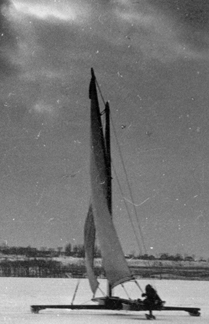 You might think that with all the salt manufacturing going on around Onondaga Lake, that the lake itself would be salty. In fact, it is a freshwater lake and home to several species of fish. In the 1800s, Onondaga Lake whitefish was served at fine restaurants in New York City, hundreds of miles away. Since it is a freshwater lake, it freezes in the winter and was a venue for ice boat races. Iceboats look like sailboats, but have runners in place of a hull. On a good day, they could skate across the frozen lake at speeds in excess of 60 m.p.h.
You might think that with all the salt manufacturing going on around Onondaga Lake, that the lake itself would be salty. In fact, it is a freshwater lake and home to several species of fish. In the 1800s, Onondaga Lake whitefish was served at fine restaurants in New York City, hundreds of miles away. Since it is a freshwater lake, it freezes in the winter and was a venue for ice boat races. Iceboats look like sailboats, but have runners in place of a hull. On a good day, they could skate across the frozen lake at speeds in excess of 60 m.p.h.
Today, Onondaga Lake Park offers many recreational opportunities for residents of Liverpool, Onondaga County, and beyond. Recreational vehicle-free paved trails welcome bicyclists, skaters, and runners. Trams run from the Salt Museum to Willow Bay during the summer months. A 16,900 square foot skate park is open April - October. A marina welcomes boaters and park visitors to the Wegmans Boundless Playground, where they will find "a magical place where all our children and adults- the fully able and those who have physical, sensory, and developmental disabilities--can play and grow together." Onondaga Lake Park is located adjacent to the Village of Liverpool. It is the crown jewel of the Onondaga County Parks system.
